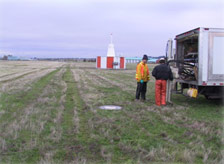|
|
Jet Fuel Storage and
Transmission Line,
Portland, Oregon


ART was retained as a consultant for the investigation of petroleum hydrocarbons impact from a jet fuel transmission line and storage facility at Portland International Airport. During September 1997, an investigation of the transmission line was completed by advancing a total of 91 Geoprobes™. Soil lithology for each Geoprobe™ was recorded. Field characterization data collected indicated a high-point valve may have had a release. ASIG performed corrective measures to fix the valve and performed a line integrity test to confirm leaks were repaired. The site is within the DEQ’s Voluntary Cleanup Program. The objective of the scope of work completed by ART was to determine the nature and extent of previously identified soil and groundwater contamination in the vicinity of the Jet A Fuel transmission line near the VOR.
Twenty-five Geoprobe™ borings were advanced down to the top of the first encountered water beneath the site. GeoTech Exploration, Inc., of Tualatin, Oregon performed the direct-push method of soil sampling utilizing the Geoprobe™ system. Field readings and observations indicated contamination to be localized near the transmission line valve points. Concentrations of petroleum hydrocarbons in the diesel ranged from 65 to 1,460 ppm in soil. Samples with detection of diesel range (quantified against a Jet A fuel standard) hydrocarbons where typically found in the Geoprobe™ borings near the low point valves. Geoprobe™ borings surrounding the boring near the low point valves did not indicate the presence of petroleum hydrocarbons. Detections were typically found at depths (5.5 to 11 feet bgs) immediately above first encountered groundwater. Groundwater sample results indicate the presence of low concentrations of BTEX and PAHs constituents in groundwater, although levels are well below RBCs.

Based on the constituents detected during the investigation, the concentrations were low and indicated a highly weathered product. The concentrations of the detected petroleum constituents are well below generic RBCs for soil in the reported categories. Based on analytical results, it does not appear that the transmission hydrant fuel line has had a recent release. The results for both groundwater and soil indicate concentrations are well below RBCs for construction and excavation workers. Since the storm drain has been slip-lined, it is unlikely that any ecological risk would be present because the most logical pathway has been eliminated. Based on historical analytical results, the most recent results, and activities conducted on the site to reduce risk of exposure, the site has been issued a “no further action” by the DEQ.

|

